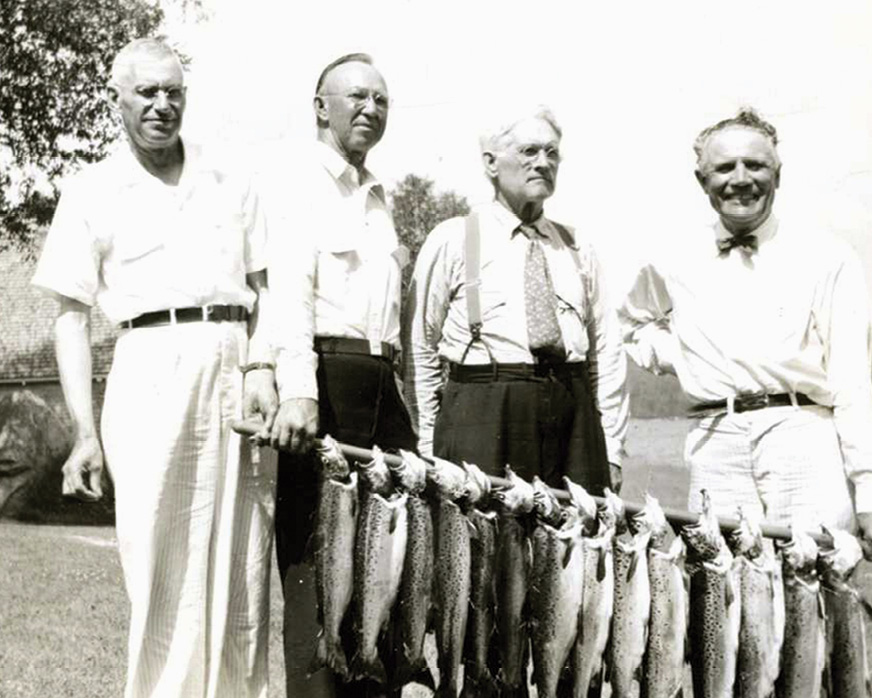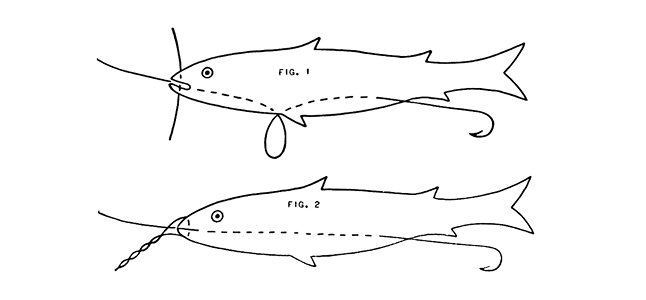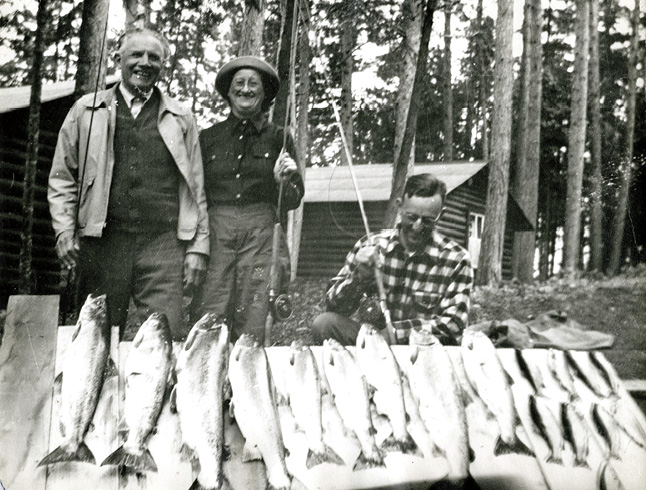Chapter 17
How to Fish for Salmon, Trout and Togue
Of all the fresh water game fishing, Salmon is my favorite. They hit hard, jump high and fight every inch of that way to the net.

Fishing party with Salmon and Trout caught at Moosehead Lake 1939. Over half of these fish were taken on Live Bait Fly as described in this chapter. Left to Dr. A.L. Gould, Willis Libby, Levi Patterson, and L.L. Bean.
During the first month after the ice goes out in the Spring I find trolling with bait the most successful. I use a sewed-on Smelt on one rod and Night Crawlers on the other. I recommend a 7 1/2 ounce 9 1/2 ft. Trolling Rod, level winding 100 yard Reel, 25 lb. test Nylon Line with markings at 50, 75 and 100 ft., a 15" Leader, two Swivels and a 12" Snelled 2/0 Hook. Row slowly and run from 50 to 100 feet of Line until you land your first fish. Note how much line you had out and continue using the same length.
For sewing on smelts and shiners I recommend the following method: Place a few gut hooks in a can of water or minnow bucket so snell will be pliable when ready to bait up.
BILL GORMAN > Not everyone knows what a gut snell is. The short section of line in front of the hook would have been silkworm gut, a natural material, so it had to be soaked before use to make it pliable. Longer leaders would have been made from catgut. Now, of course, we have monofilament and other synthetic materials for lines and leaders.
1st. String minnow lengthways on snell by passing hook through mouth, out at belly then right back through same hole and out at side as shown in Fig. 1.

2nd. Draw snell tight which takes out loop and forces snell to pass straight through minnow as shown in Fig. 2.
3rd. Stick point of hook into side of minnow between the two tail fins.
4th. Close mouth with little wire as shown in Figs. 1 and 2.
5th. Crowd minnow back into hook so as to form a bend.
6th. Wind twisted wire around snell twice and try trolling at side of boat. Bait should turn to imitate wounded minnow. If too slow put in more bend. When satisfactory, wind balance of wire around snell and you are ready to fish.
The little wires cost only 15c for a tube of fifty.
When you have no luck trolling, try changing your bait to different levels in the water by adding to, or reducing, the weight of your sinkers.

After the first month I run a live bait fly, as illustrated (above), on one rod and a sewed-on minnow on the other. A shiner hooked through the lips as shown will keep alive for about two hours. Do not stick tail hook into minnow. I use a 5 ½ ounce Fly Rod for the live bait fly. Later in the season when it gets warm and the fish go into deep water it is much more difficult to get them to take surface bait. Many times it becomes a question of going home empty handed or resorting to a somewhat unsportsmanlike method of deep trolling.

The author, L.L. Bean, Mrs. L.L. Bean and Jack Gorman. Nine Atlantic salmon and nine trout caught June 4th, 5th, 6th and 7th, 1945, on Tobique River, near Plaster Rock, Canada. The salmon weighed 20 1/4 to 6 lbs. The trout 2 1/4 to 1 3/4 lbs. Six salmon were taken on Silver Gray, one on Mar Lodge No. 4 double hook, and two on Jock Scott No. 2 double hook. L.L. Bean used a 5 1/2 oz. rod. Mrs. Bean and Mr. Gorman a 7 1/2 oz. rod. The trout were taken on a 4 1/2 oz. rod with Edison Tiger Dark Fly No. 6 hook.
For deep trolling you need a very stiff rod, a solid 150 yard reel and metal covered 100 yard line. Use a set of spoons size 2 to 6/0 according to the depth of water with plenty of swivels. Run sewed-on minnow on one rod and night crawlers on the other. Use a short snelled 2/0 hook without leader so that bait is not over 8 inches from tail spoon. Keep a few hooks soaking in bait pail as it is about impossible to sew on minnows with a dry snelled hook.

Introduced in 1951, this new leader pack “does away with fussing with loose coils.”
Always carry a ruler of some kind to be sure fish is legal length. When returning fish to water wet both hands and use a hook disgorger.
Trout and togue are caught in the same way as salmon except you troll a little slower and fish a little nearer shore for trout and farther away for togue.
Do not strike your fish too quickly. Strip off a few yards of line so as to give it time to get bait and hook well into its mouth. This is important and applies to both trout and salmon, the former especially are very slow taking in bait.
I have recommended a metal covered line which I prefer but any line which tests thirty-six pounds or more is O.K. Fly fishing is explained in Chapters 22, 23, 24 & 25. All game fish should be cleaned immediately after they are caught.
What we consider unsportsmanlike has always been a shifting matter of opinion and perspective. This has never been more true than in the conservation ethics of practicing catch and release, which has become a big force in modern angling and fishing in Maine.

The idea of releasing fish unharmed — to protect their numbers and the quality of the fishing experience for everyone — began in the late fifties in some of the country’s best-known trout-fishing regions. Catch and release has become a tremendously successful sport fisheries management practice, taking hold especially with the rise in popularity of fly-fishing in the past twenty years. Many anglers release every fish they catch, or plan to harvest only a few for the frying pan over the course of a fishing season, and the state has made many of our best waters catch and release by regulation to protect trout and salmon numbers and angling quality. Often combined with restrictions for artificial lures only or fly-fishing only, catch and release is an important part of Maine’s conservation landscape.
That said, I’m not one to condemn someone for occasionally keeping fish, because I’m going to. It’s part of fishing — it’s part of our heritage. You should be proud to eat what you harvest, and there shouldn’t be any apologies for that. Of course, there are exceptions. For instance, I won’t kill a species of fish that is on a downward population trend. Catch and release is a great way that we can enjoy the outdoors and reduce our impact in places as part of our resource management. That’s what conservation is: It’s the responsible use of a renewable resource.
— Bill Gorman